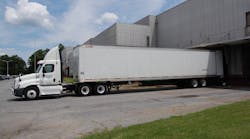It’s been an ongoing contention for years that trucking is undervalued for the supply chain services it provides – especially when it comes to truck driver wages. And while freight rates are on the rise, which provides motor carriers with fund necessary to boost driver pay, there’s still a widespread feeling within the industry that shippers consider trucking nothing more than a commodity, with drivers, fleets, trucks and trailers all the same; all interchangeable from one to the next.
Back in October of last year, John Larkin – formerly head of transportation research for Stifel Capital Markets and now with the firm’s banking decisions – referred to shipper behavior in the pre-electronic logging device (ELD) mandate world as “Neanderthal practices” and noted that trucking companies keep very long memories about them.
“A couple of people sent me letters from shippers during that [pre-ELD] time which said, ’We’re so grateful for all the great service you’ve provided to us over the years; however, we’re notifying you that we’re going to take our [freight] prices down 10% effective the Monday after next. If you’re willing to absorb that price discount that’s great, we’d be happy to have you in our carrier mix; if not we’ll put your business out to bid and you may win some of that, you may lose all of it. The likelihood of you winning it all back is zero,’” he noted in his remarks.
“That’s pretty harsh,” Larkin stressed. “That’s treatment of somebody who’s supposed to be your partner and I think some of those folks are going to see the other end of that here very shortly. It’s hard to feel too sorry for them.”
With all that in mind, then, a call for new supply chain costing methods being made by APICS, an association representing supply chain management professionals, and IMA, the Institute of Management Accountants, could be both welcome and worrisome.
On the one hand, getting a better accounting of supply chain costs is a good thing, as more accuracy in monetary matters usually leads to better outcomes, noted Raef Lawson, IMA’s vice president of research and policy.
"From the supply chain perspective, an effective managerial costing system has clear value. It enables better make-or-buy decisions, defines landed versus delivery costs and determines the realistic cost of holding inventory," he explained.
However, if such “costing” improvements leaves trucking yet again with the short end of the monetary stick, that won’t be a such a great development – especially if it continues to foster a “cheap freight” mentality.
The APICS/IMA report found that when asked what prevents supply chain managers from maximizing the use of current costing information, 44% of those polled cited a lack of operational data. Instead, costing information is often reported in exclusively financial terms, making it more difficult to leverage. Respondents added that the secondary and “tertiary barriers” to useful costing information are inadequate technology and software (39%) and a resistance to change by accounting and finance personnel (30%).
According to the report, there are three root causes why supply chain professionals are not receiving adequate costing information:
- An overreliance on external financial reporting systems:Many organizations rely on externally-oriented financial accounting systems that employ oversimplified methods of costing products and services to produce information supporting internal business decision making.
- Using outdated costing models:Traditional cost accounting practices can no longer meet the challenges of today's business environment, but are still used by many accountants.
- Accounting and finance's resistance to change:With little pressure from managers who use accounting information to improve data accuracy and relevance, accountants are reluctant to promote new, more appropriate practices within their organizations.
Again, though, if revamping cost calculation strategies within the supply chain results in a better appreciation of trucking’s role – especially from a freight rate and driver pay perspective – then it’ll be a worthwhile effort to pursue. We’ll wait and see how it turns out.



